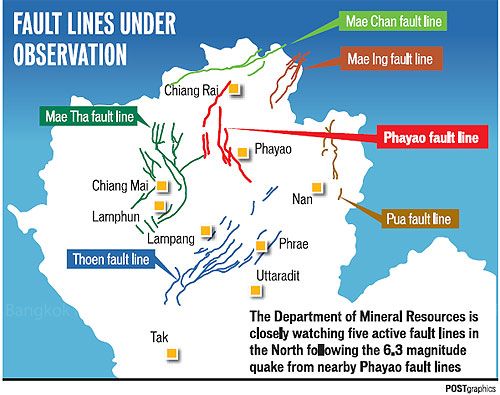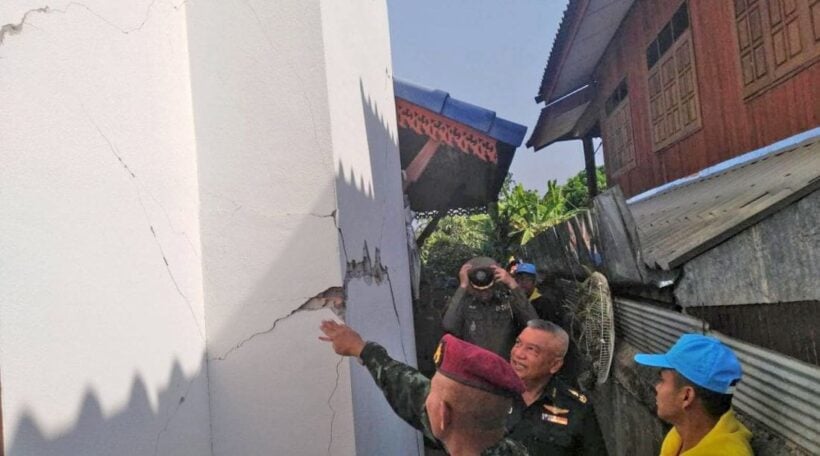Experts warn of northern faultlines as aftershocks rock Lampang

PHOTO: Wat Phra Kerd’s abbot leads officials to inspect the damage to the pagoda’s visibly tilted tiered umbrella top after Lampang’s Wang Nua district on Wednesday suffered a 4.9magnitude quake.
The recent tremors around Lampang slightly damaged a few dozen homes in six tambons, including the tiered umbrella of the Wat Phra Kerd pagoda in tambon Thung Hua.
The 4.9 magnitude quake also cracked some walls and knocked off tiles in the Tambon Rong Koh Administrative Organisation and Tambon Thung Hua Administrative Organisation buildings, prompting officials to evacuate.
Luckily the 25+ quakes and aftershocks in Lampang’s Wang Nua district on Wednesday and yesterday didn’t cause too much damage. But academics remain concerned about the North, as it has several faultlines scattered across the region.
Penneung Wanichchai, seismologist at the Asian Institute of Technology, who has served as head of the Thailand Research Fund’s quake-disaster prevention project, said that in theory, a 4.9 magnitude quake can be dangerous.
He says that the Phayao faultline should not be blamed for the Lampang quakes.
“In reality there are many more faultlines under the earth’s surface. These quakes may have stemmed from other faultlines. We may be worried about residents living near visible faultlines, but I’m worried about the entire region.”
“There can be a quake at any time, as seen in the May 5, 2014 earthquake in Chiang Rai. The Lampang quakes have made us realise that quakes can happen any where, so people should be aware,” Penneung said.

“Houses should be reinforced with metal and larger pillars,” he said, adding this team had reinforced four school buildings and were currently working on another four.
He says the government should add another 15 percent to the budget for constructing state buildings – especially schools and hospitals – so they could be suitable reinforced.
The Thai Meteorological Department’s Earthquake Observation Division has blamed the quakes on the Phayao faultline, which passes through Phayao, Lampang and Chiang Rai provinces.
So far, the 4.9-magnitude quake at 4.05pm on Wednesday in Lampang’s Wang Nua district was the biggest, while the latest 2.6-magnitude aftershock occurred at 6.07am yesterday, the centre said.
Teraphan Ornthammarath, who leads the TRF project for mapping out quake-risk areas in Thailand, said that though the Lampang earthquakes did not cause much damage, people should still stay out of risky buildings in case there are more violent aftershocks.
Citing the inspection of damages in Lampang’s tambon Thung Hua, he said the tambon administrative organisation’s building only suffered cracks in the wall, while the pillars and beams were unaffected. He said only one house in the tambon was coded “red”, as the metal interiors of a pillar had been exposed.
The Lampang quakes could be felt in the provinces of Chiang Mai, Phayao and Chiang Rai. Many Chiang Rai residents worried this might be a repeat of the 2014 6.3-magnitude quake, which had shaken Phan district, damaged buildings and caused “superficial” cracks to the Mae Suay dam.
Mae Suay district chief Kitti Chaidarun said the main dam was not affected by the Lampang quakes.

SOURCE: The Nation
Latest Thailand News
Follow The Thaiger on Google News:


























